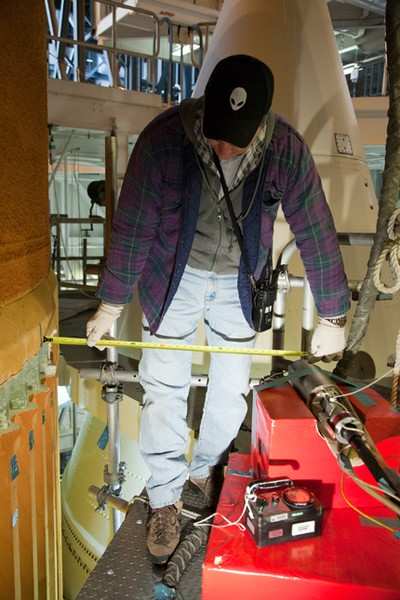Sat, Jan 08, 2011
Firm Launch Date (As Firm As Such Things Get) To Be Determined
Next Week
NASA managers are evaluating potential launch dates for space
shuttle Discovery in late February and working to see if
International Space Station on orbit operations would allow a
launch as early as Feb. 24. More will be known next week and
managers hope to set a launch date by the end of next week.

Progress continues to be made in understanding the most probable
cause of cracks discovered on Discovery's external tank
mid-section, known as the intertank, where small cracks developed
during the Nov. 5, 2010, launch attempt. Four additional small
cracks were found during thorough X-ray of the backside of the tank
after Discovery was returned to the Vehicle Assembly Building
before Christmas.

Plans are for the repair work to continue through the weekend.
The shuttle program also reviewed the plan to modify as many as 32
additional stringers with radius blocks, which will provide added
structural support in areas known to carry much of the structural
load of the external tank. These radius blocks essentially fit over
existing stringer edges through which the securing rivets are
installed to provide additional structural support. The radius
block modification is a known and practiced structural augmentation
technique used extensively on the intertank. This work should begin
as soon as the repairs to the three stringers with the four
additional small cracks have been completed, likely in the next day
or so, and the modification of the additional 32 stringers is
expected to be complete next week.

NASA managers will meet with Space Shuttle Program officials
Monday to review the progress to date and the forward plan. A
determination of the need and viability for the installation of
additional radius blocks on all remaining stringers will be made
sometime next week. With the work remaining, the potential for
additional modifications yet to be defined, and further reviews
pending, the decision was made Thursday to allow the teams
additional time and delayed the targeted launch date out of the
early February launch window. Launch dates for Discovery and
Endeavour will be discussed at next Thursday's Space Shuttle
Program Requirements Control Board meeting.
More News
Light Gun A handheld directional light signaling device which emits a brilliant narrow beam of white, green, or red light as selected by the tower controller. The color and type of>[...]
"The journey to this achievement started nearly a decade ago when a freshly commissioned Gentry, driven by a fascination with new technologies and a desire to contribute significan>[...]
Aero Linx: JAARS, Inc. For decades now, we’ve landed planes on narrow rivers and towering mountains. We’ve outfitted boats and vehicles to reach villages that rarely se>[...]
"Our driven and innovative team of military and civilian Airmen delivers combat power daily, ensuring our nation is ready today and tomorrow." Source: General Duke Richardson, AFMC>[...]
Aircraft Conflict Predicted conflict, within EDST of two aircraft, or between aircraft and airspace. A Red alert is used for conflicts when the predicted minimum separation is 5 na>[...]
 ANN's Daily Aero-Term (04.20.24): Light Gun
ANN's Daily Aero-Term (04.20.24): Light Gun Aero-News: Quote of the Day (04.20.24)
Aero-News: Quote of the Day (04.20.24) ANN's Daily Aero-Linx (04.21.24)
ANN's Daily Aero-Linx (04.21.24) Aero-News: Quote of the Day (04.21.24)
Aero-News: Quote of the Day (04.21.24) ANN's Daily Aero-Term (04.21.24): Aircraft Conflict
ANN's Daily Aero-Term (04.21.24): Aircraft Conflict





